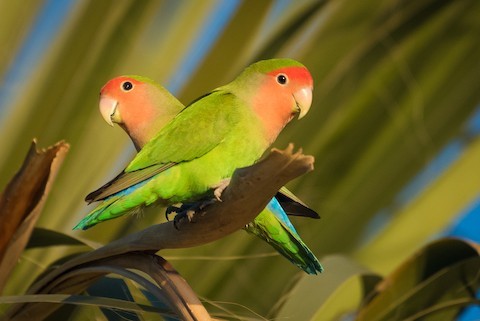Birdfinding.info ⇒ Common in its native Namibia, where it can be found at many of the frequently visited sites, including Etosha and Waterberg Plateau National Parks and Erongo Wilderness Lodge. Also increasingly common in Arizona at most Phoenix metropolitan area parks (e.g., Granada Park, Encanto Park, Kiwanis Park, Papago Park, and the Riparian Preserve at Water Ranch in Gilbert). In Hawaii, it is locally common on Maui around Kihei and on the Big Island at Waikoloa.
Rosy-faced Lovebird
Agapornis roseicollis
Family: Psittaculidae
Arid and semiarid zones of southwestern Africa.
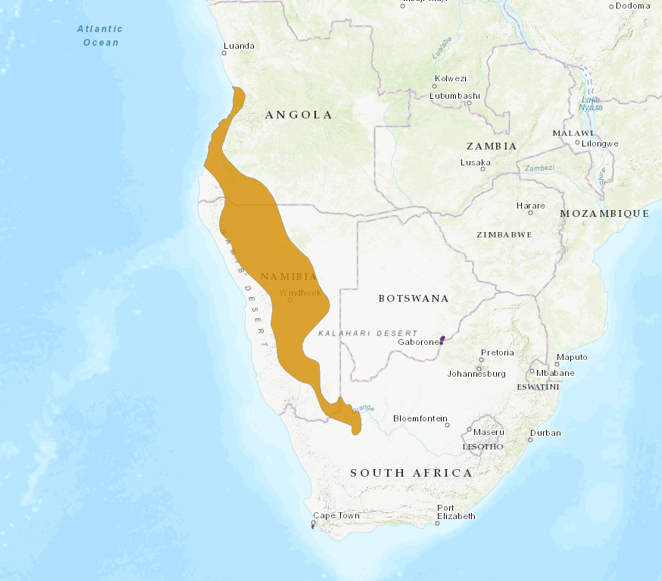
Approximate natural range of the Rosy-faced Lovebird. © BirdLife International 2018
Natural range consists of most of Namibia north into southwestern Angola and south into southwestern Botswana and northwestern South Africa, where it inhabits desert scrub, brush, and dry woodland.
Widely kept as a pet, which has resulted in several escapee or introduced populations. The largest is in central and southern Arizona, where it is well established in the Phoenix metropolitan area and expanding south and east through Tucson and beyond.
Introduced populations are also established in Johannesburg, South Africa, and in Hawaii, on Maui (mainly Kihei, but expanding) and the Big Island (mainly Waikoloa, but also south to Kealakekua).
Much smaller populations are more tenuously established in the West Indies (on Grand Bahama and Puerto Rico) and on the Iberian Peninsula, along south coast of Portugal and into southern Spain (Isla Cristina and Málaga).
Identification
A small, green parrot with a pale-yellowish bill, pinkish, orange, and rosy face and bib, and blue rump.
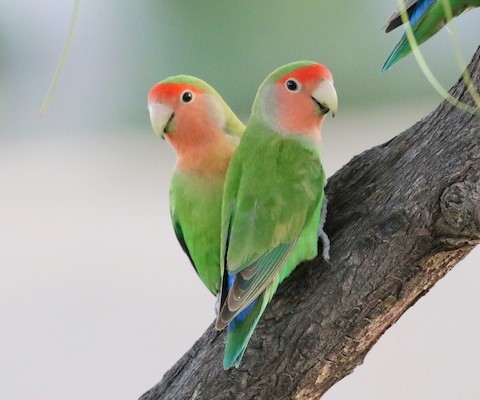
Rosy-faced Lovebird, pair showing typical “peach-faced” coloration. (Riparian Preserve at Water Ranch, Gilbert, Arizona; March 20, 2017.) © Kenneth Trease
The facial coloration varies in intensity from pale pastel-pink to dark ruby-red, usually much darker and more vivid-colored on the forehead, and mostly pale below the eye.
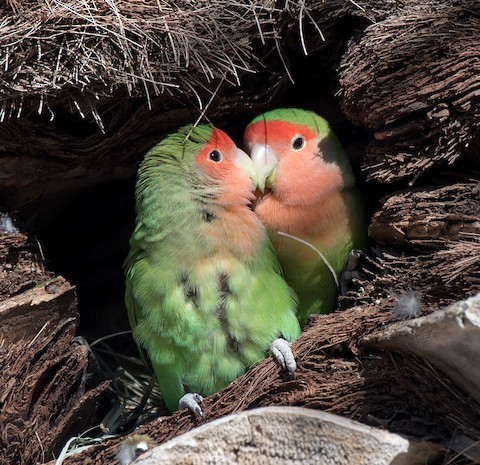
Rosy-faced Lovebird, pair showing typical “peach-faced” coloration. (Kiwanis Park, Tempe, Arizona; October 25, 2019.) © Gordon Karre
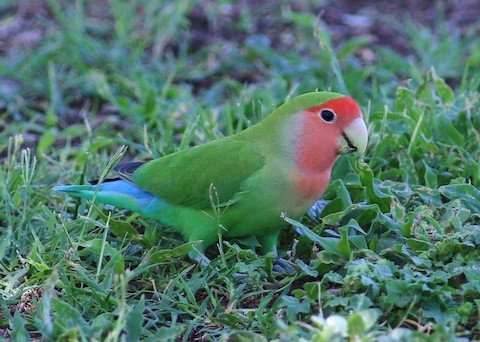
Rosy-faced Lovebird, showing vivid overall coloration. (Encanto Park, Phoenix, Arizona; May 29, 2015.) © Tom Benson
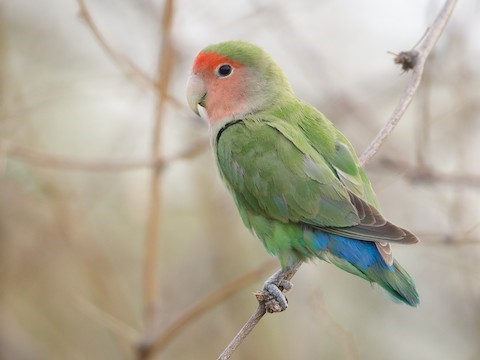
Rosy-faced Lovebird, showing dull, faded coloration. (Riparian Preserve at Water Ranch, Gilbert, Arizona; December 11, 2017.) © Darren Clark
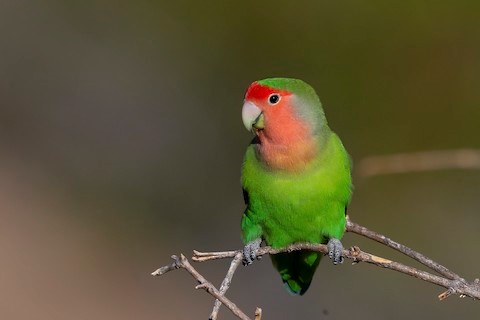
Rosy-faced Lovebird, showing vivid facial color, with ruby-red forehead. (Erongo Wilderness Lodge, Omaruru, Namibia; January 9, 2019.) © Niall D. Perrins

Rosy-faced Lovebird, showing generally vivid coloration. (Granada Park, Phoenix, Arizona; March 12, 2020.) © Mary McSparen
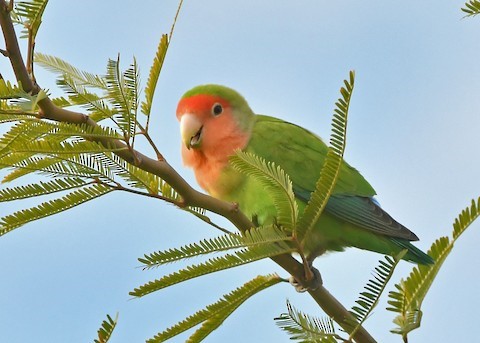
Rosy-faced Lovebird, pair showing typical “peach-faced” coloration. (Electric Park, Mesa, Arizona; January 3, 2018.) © Glenda Jones
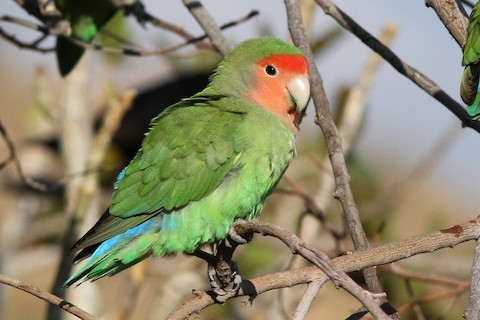
Rosy-faced Lovebird, showing all-green body plumage and turquoise rump. (Erongo Wilderness Lodge, Omaruru, Namibia; November 9, 2017.) © John Martin
The body plumage can be essentially all-green but often shows a strong yellowish tinge and a variable amount of orange on the chest.
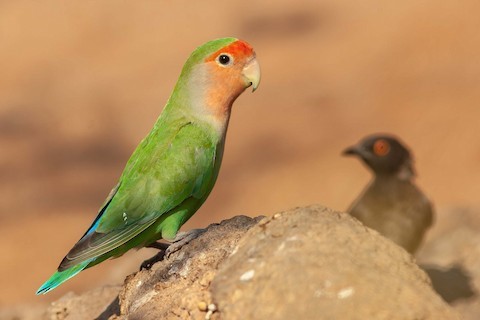
Rosy-faced Lovebird, showing yellowish-green upperparts. (Etosha National Park, Namibia; September 18, 2014.) © Roland Bischoff

Rosy-faced Lovebird, showing yellowish-green body plumage, becoming orange on the chest. (Kiwanis Park, Tempe, Arizona; November 11, 2016.) © Ryan O’Donnell

Rosy-faced Lovebird, showing mostly yellowish-green underparts. (Riparian Preserve at Water Ranch, Gilbert, Arizona; December 11, 2017.) © Gordon Karre
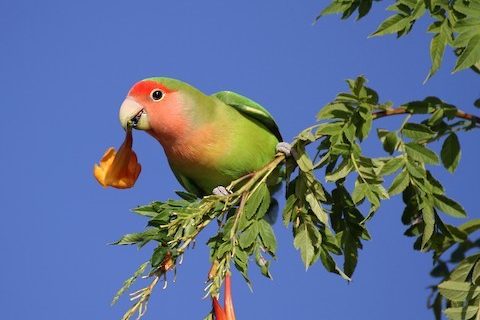
Rosy-faced Lovebird, showing yellowish-green body plumage, becoming orange on the chest. (ASU Research Park, Tempe, Arizona; October 11, 2019.) © Andrew Theus

Rosy-faced Lovebird, showing all-green body plumage and an orange transition on the chest. (Kiwanis Park, Tempe, Arizona; September 10, 2019.) © R.J. Baltierra
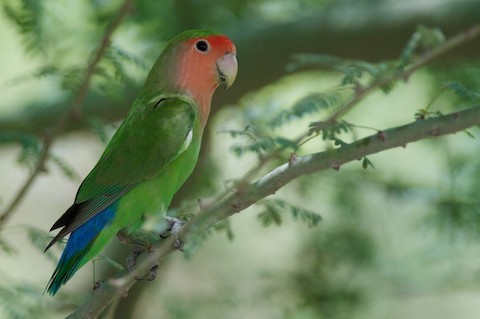
Rosy-faced Lovebird, showing vivid, deep-blue rump. (Kiwanis Park, Tempe, Arizona; August 11, 2016.) © Amanda Guercio
The rump color varies from dull to vivid, but is usually at the vivid end of the spectrum and therefore conspicuous.
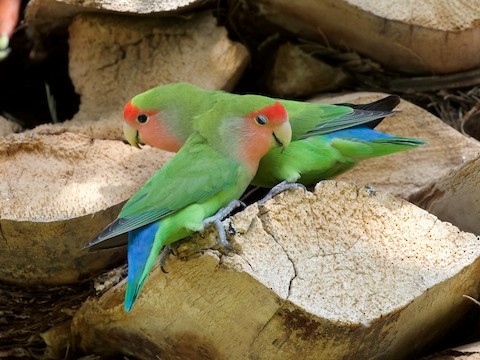
Rosy-faced Lovebird, pair showing vivid blue rumps. (Kiwanis Park, Tempe, Arizona; September 10, 2019.) © R.J. Baltierra

Rosy-faced Lovebird, showing turquoise in raised wings, but dark-blue on rump. (Kennedy Park, Tucson, Arizona; March 25, 2016.) © Craig Thayer
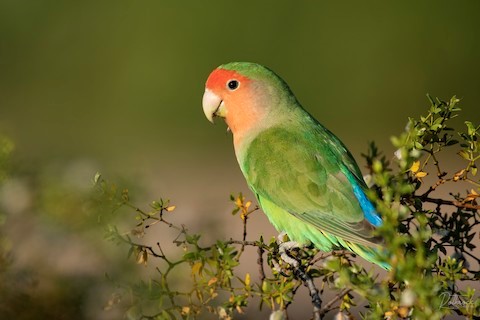
Rosy-faced Lovebird, showing turquoise rump. (Evelyn Hallman Park, Tempe, Arizona; May 17, 2020.) © Neil Rucker

Rosy-faced Lovebird, showing dull royal-blue rump. (Encanto Park, Phoenix, Arizona; February 26, 2013.) © Joe Wing

Rosy-faced Lovebird, pair—dorsal view of foreground bird with wings and tail spread, showing red and black at base of tail feathers. (Kgalagadi Transfrontier Park, South Africa; August 3, 2008.) © Oscar Campbell
At the base of the tail are black and red stripes that are rarely visible unless the tail is spread.
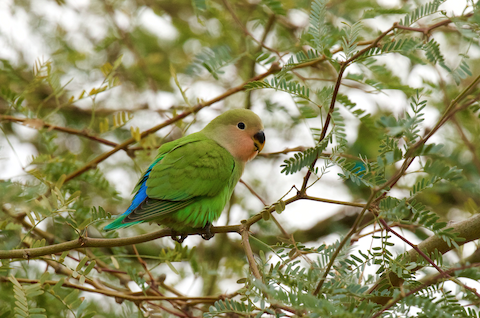
Rosy-faced Lovebird, immature. (Granada Park, Phoenix, Arizona; December 29, 2016.) © Nick Dorian
Immatures tend to appear more yellowish-green than adults, with a pale-pink face, dull-colored forehead, and mostly blackish upper mandible. Like adults, immatures have blue rumps.
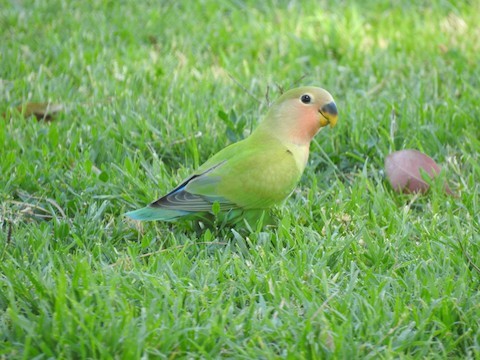
Rosy-faced Lovebird, immature, showing mostly blackish upper mandible. (Kiwanis Park, Tempe, Arizona; April 19, 2019.) © Frank Fabbro
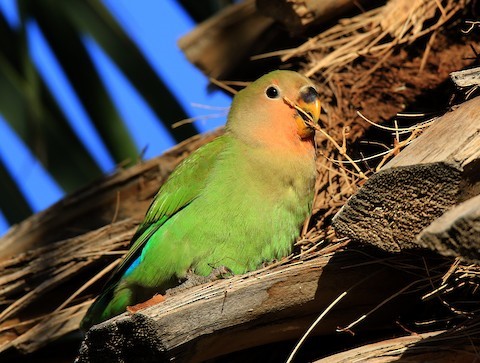
Rosy-faced Lovebird, immature, showing mostly blackish upper mandible. (Kiwanis Park, Tempe, Arizona; April 21, 2018.) © Moe Bertrand
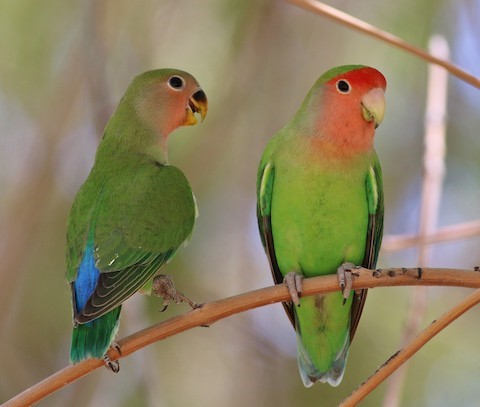
Rosy-faced Lovebird, immature and adult. (Encanto Park, Phoenix, Arizona; May 29, 2015.) © Tom Benson
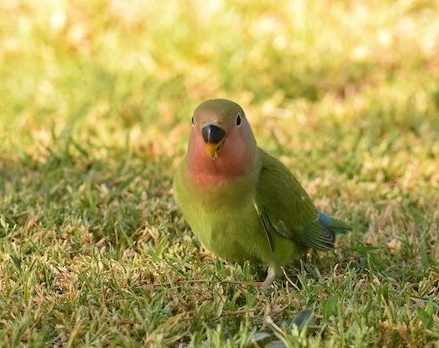
Rosy-faced Lovebird, immature, showing mostly blackish upper mandible and dull forehead. (Kiwanis Park, Tempe, Arizona; April 23, 2016.) © Ryan O’Donnell
The immature’s head is usually more orange, sometimes brownish, rather than yellow or green.

Rosy-faced Lovebird, immatures. (Waterberg Plateau National Park, Namibia; February 19, 2014.) © Tadeusz Rosinski
The immature’s bill turns yellow before the plumage changes to adult coloration.

Rosy-faced Lovebird, immature with pale upper mandible. (Papago Park, Phoenix, Arizona; February 20, 2020.) © Vic Dillabaugh
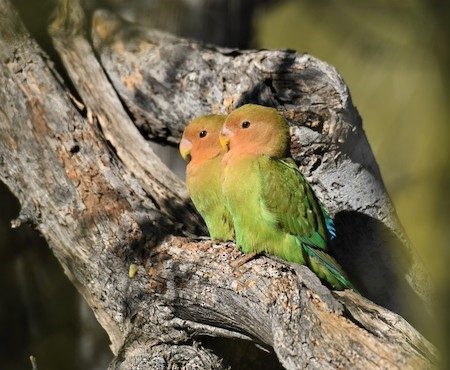
Rosy-faced Lovebird, immatures with pale upper mandibles. (Usery Mountain Regional Park, Mesa, Arizona; January 13, 2020.) © Joe Girgente
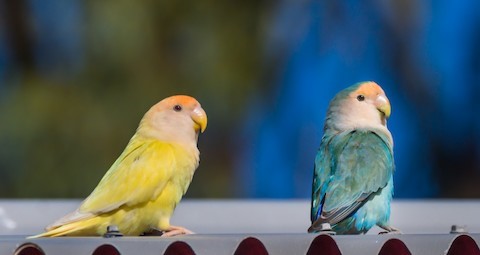
Rosy-faced Lovebird, evidently inbred, with atypical yellow and blue plumages. (Waikoloa, Big Island, Hawaii; December 30, 2019.) © Jim Merritt
As occurs with various types of cagebirds bred in captivity, most introduced populations include some individuals with wildly atypical plumages, which can include all-yellow, all-powder-blue, and variants on the natural coloration.
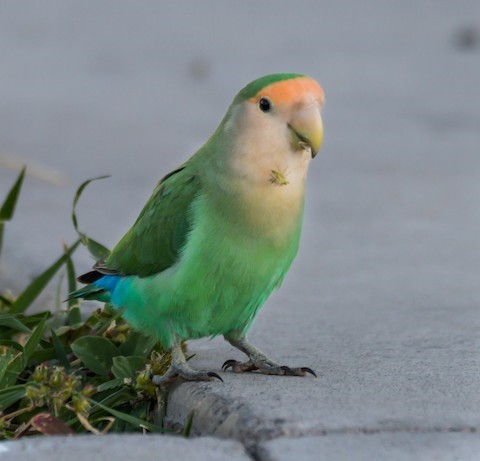
Rosy-faced Lovebird, evidently inbred, with atypical peach-colored forehead, whitish face, and bluish-green underparts. (Waikoloa, Big Island, Hawaii; January 1, 2020.) © Jim Merritt
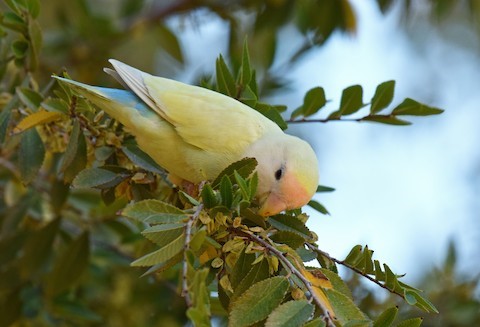
Rosy-faced Lovebird, evidently inbred, with atypical canary-yellow plumage. (Kiwanis Park, Tempe, Arizona; November 11, 2016.) © Ryan O’Donnell
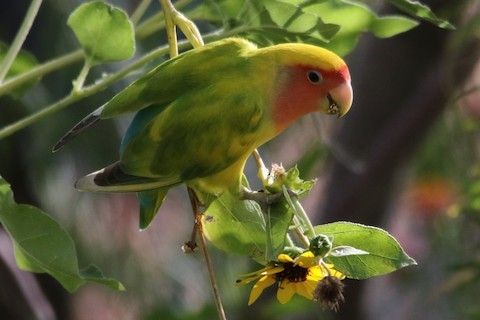
Rosy-faced Lovebird, evidently inbred, with atypical yellow patches in plumage. (Desert Botanical Garden, Phoenix, Arizona; September 23, 2017.) © Louis Hoeniger
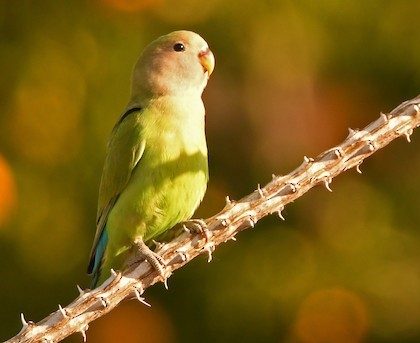
Rosy-faced Lovebird, evidently inbred, with atypical canary-yellow plumage. (Electric Park, Mesa, Arizona; January 3, 2018.) © Glenda Jones
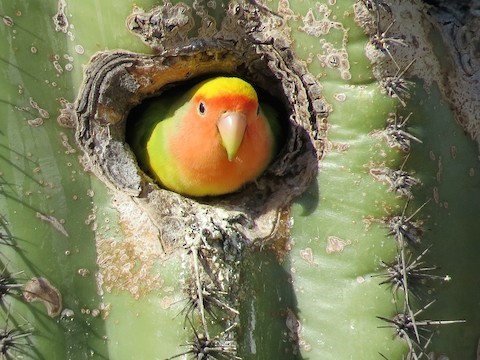
Rosy-faced Lovebird, in nest hole, evidently inbred, with atypical yellow plumage. (Paradise Valley, Arizona; April 3, 2019.) © Susan Fishburn
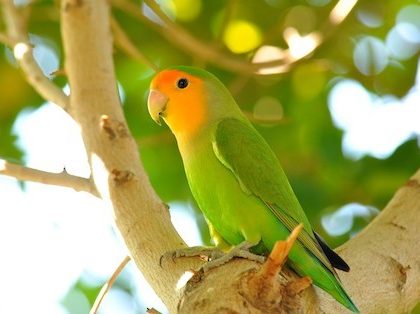
Rosy-faced Lovebird, evidently inbred, with atypical orange face. (Kiwanis Park, Tempe, Arizona; September 24, 2015.) © Ryan O’Donnell

Rosy-faced Lovebird, evidently inbred, with atypical whitish and powder-blue plumage. (Kiwanis Park, Tempe, Arizona; October 25, 2019.) © Gordon Karre
Cf. Red-faced Lovebird. Red-faced and Rosy-faced Lovebirds are not known to overlap naturally but their ranges may come close in Angola. As with other parrots that are prized as pets, either one could occur nearly anywhere through escape or introduction.
These two species are similar and show enough internal variation to cause confusion. Helpful distinctions include:
Rump and Tail: The most consistent distinction is that Rosy-faced has a blue rump, usually bright-blue and conspicuous. Red-faced can have a small amount of blue on the rump, but it rarely evident. Instead, Red-faced typically shows some red and black at the base of the tail—though this is most visible in flight and may be difficult to see without an optimal view of the tail. (Note that Rosy-faced also has some red and black at the base of the tail, but less than on Red-faced and rarely visible.)
Face Coloration: In both sexes, at all ages, Rosy-faced has a mostly pinkish face. In adults the forehead is a darker shade of red. In Red-faced, adult males have an entirely red face, from the forehead to the throat; whereas females and immatures have a mostly orange or yellowish face.
Bill: Adults of the two species have different bill colors: pale-yellowish in Rosy-faced versus pink-orange in Red-faced.
Notes
Polytypic species consisting of two recognized subspecies. Also known as Peach-faced Lovebird.
References
BirdLife International. 2018. Agapornis roseicollis. The IUCN Red List of Threatened Species 2018: e.T22685342A131916302. https://dx.doi.org/10.2305/IUCN.UK.2018-2.RLTS.T22685342A131916302.en. (Accessed July 22, 2020.)
eBird. 2020. eBird: An online database of bird distribution and abundance. Cornell Lab of Ornithology, Ithaca, N.Y. http://www.ebird.org. (Accessed July 22, 2020.)
Forshaw, J.M. 2010. Parrots of the World. Princeton University Press.
Juniper, T., and M. Parr. 1998. Parrots: A Guide to Parrots of the World. Yale University Press.
Pyle, R.L., and P. Pyle. 2017. The Birds of the Hawaiian Islands: Occurrence, History, Distribution, and Status. Version 2 (January 1, 2017). http://hbs.bishopmuseum.org/birds/rlp-monograph/. B.P. Bishop Museum, Honolulu, Hawaii.
Sinclair, I., P. Hockey, W. Tarboton, and P. Ryan. 2011. Birds of Southern Africa (Fourth Edition). Random House Struik (Pty) Ltd. Cape Town, South Africa.
van Perlo, B. 1999. Birds of Southern Africa. Princeton University Press.
Xeno-Canto. 2020. Rosy-faced Lovebird – Agapornis roseicollis. https://www.xeno-canto.org/species/Agapornis-roseicollis. (Accessed July 22, 2020.)
